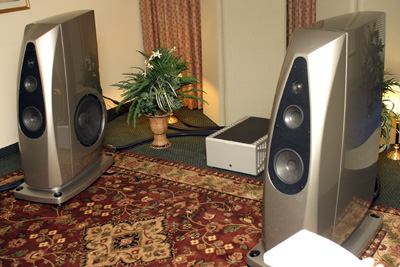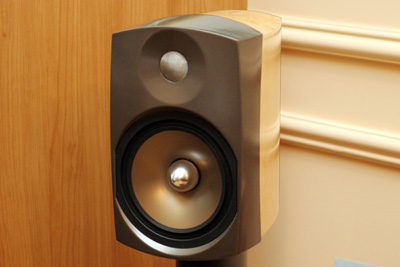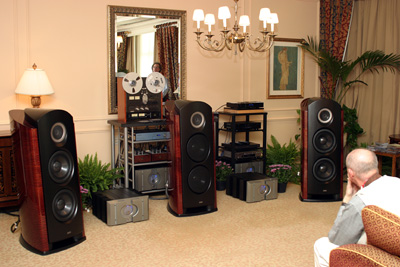I heard an over-$200,000 speaker system today surrounded by about $350,000 of
electronics. I did not get the center spot of the couch, but from what I could hear on the
end of the sofa it sounded quite good. It should have -- and much more -- for half
a million dollars. I don’t think that amount of money is inconsiderable even to the
wealthiest among us, especially as an audio-system budget.
Although my concern for the industry is at an all-time high due to the exorbitant price
tags of some occasionally questionable products, I do have hope. At CES I’ve seen
some good companies making high-value equipment, and the prices of these components span
the range from several hundred to many thousands of dollars. It’s being able to
separate what’s good from what’s not -- at whatever price point you’re
shopping -- that’s the key.
I think those of us in the press need to do a better job of illuminating the good stuff
and alerting you to the mediocre or just plain bad. Although we at the SoundStage! Network
are careful to diversify our coverage with sites like www.goodsound.com, dedicated solely to high-value gear, there’s
more to be done across the spectrum. As it stands now there isn’t enough guidance to
confidently navigate all the waters of high-end audio. I do know that my fellow
SoundStagers are committed to the task, as we all have been for years. After all, even the
shrewdest of us can waste a lot of money trying to figure it all out.
CES can lead to sensory overload, and now that I’m done with the final day
I’m sure my enthusiasm for all that I’ve seen is blunted by tired feet and a
desire to get home. But I still leave Las Vegas wondering if next year it’ll be
$500,000 garage-built speakers and $100,000 CD players using $25 transports. I hope not. I
just don’t think the industry can survive it for much longer. It should be an
interesting 2007.
***
The procession of contenders for the state of the art in loudspeakers continued today.
I don’t think Marc Mickelson and I heard much of anything speaker-wise priced below
$5000. Part of that is by design -- the high-priced stuff is our beat. But that beat has
grown exponentially over the last few years -- and my feet are starting to hurt!
I think in many ways the extreme price of today’s high-end products is due to
market pressure. Not all that many people buy over-$50,000 loudspeakers. But to be
considered legitimate, at least in some markets, high-end speaker companies seem to need a
statement product in the line. The problem with this is that some of these speakers are
making the wrong statement. I’m not the first person to say that big speakers can
have big problems, but it’s true. I heard some real problems today. I make a point of
never slamming a manufacturer in our show report, because there are just too many
variables at trade shows that I’m not familiar with -- bad room acoustics, poor
associated components, rushed setup, and sub-par AC among them. So although the offender
will remain nameless here, I did hear a massive loudspeaker that had so many sonic
issues that it was almost laughable -- and it was priced at over $75,000 per pair! Wait,
now that I think about it, I heard two such speakers today.

On the flip side, I did hear a few elaborate systems -- from Rockport Technologies,
Verity Audio, Wilson Audio, and YG Acoustics -- that were spectacular. I guess at the end
of the day the market will decide what’s going to fail and what will succeed, and
that’s as it should be. I can’t, though, get beyond the fact that many
audiophiles think price and performance march together in locked step. And for that reason
I’m going to dedicate myself to helping dispel that myth in 2007. I won’t be the
first guy to join that fight -- our publisher Doug Schneider has been doing it for years
in his stand-mounted speaker reviews -- but I will be the next to try to make a dent in a
rather insidious industry lie.
* * *
Canadian powerhouse Paradigm has brought beryllium-tweetered loudspeakers to a new
price point. Starting with the company’s Signature S1 v.2 monitor (below, $1600/pair)
and continuing up the Signature line to the flagship S8 v.2, the lucky customer gets a
thoroughly modern speaker system with a beryllium tweeter for what the company says is
extremely good high-frequency performance -- the first break-up mode in the new tweeter is
around 50kHz. What this could mean for the sound you’ll hear is anyone’s guess,
but I can tell you that it is refreshing to see a company pushing technology to new
heights while remaining grounded in the realm of affordability. I will be listening to,
and writing about, the next-to-the-top-of-line Signature S6 v.2
($4000/pair) soon on Ultra Audio.

Speaking of affordability, or the lack thereof, the loudspeaker market is exploding in
the over-$50,000 price range. Marc Mickelson and I were struck by the number of
stratospherically priced loudspeakers we found in room after room at the Venetian. A
$20,000 speaker is just the middle of the pack for quite a few companies, with the
$50,000-$150,000 range more popular than I would have ever imagined. In fact, it
wasn’t uncommon to hear manufacturers and dealers discussing the
"affordability" of anything below $20,000. While I’ve been known to buy
some crazy-priced gear myself, I’m disturbed (hold the jokes). More and more
audiophiles, and audio journalists, equate a high price with better performance before
even hearing the products. I can tell you that I heard several expensive speakers bettered
by lower-priced models from other manufacturers.
All of this raises the question of whether an affordable product like the new Paradigm
Signature v.2 speakers would be considered in the upper echelon of the loudspeaker world
by certain folk. I’m sure that to a specific segment of the audiophile market, the
answer is "no way." But this attitude is wrong-headed to me. In the end, you
just have to use performance as the final arbiter, not price. As obvious as that seems,
it’s just not a universal belief.
* * *
Over the past few years we’ve covered various iterations of TAD's top loudspeaker.
We first heard the Model-1 back in 2003 and were impressed enough to call that demo a Standout. The Model-1 never made it to market, however, due at least
in part to the difficulty of manufacturing its multi-ply cabinet. Last year the
replacement for the Model-1 speaker was shown. The Model-2 used similar drivers, including
the concentric beryllium midrange-tweeter that makes up the TAD CST drive unit. Alas, the
Model-2 never made it to production either.

Well, hold on to your hats -- it appears that a production model of the big TAD speaker
will make it to market in 2007, and it’s a doozie. Listening to the
TAD Reference One, I was struck by the uncanny clarity and coherence that this large
330-pound speaker was able to produce. The multichannel demo I heard, conducted by chief
TAD engineer Andrew Jones, was a sonic knockout. These loudspeakers possess a huge dynamic
envelope that will fill even the largest of rooms, and they also do detail in a way few
other speakers could ever hope to.
The cost of all of this technology is steep, however. The Reference One will be priced
somewhere between $50,000 and $60,000 per pair. I hope to hear more of this speaker and
have my fingers crossed that this long-in-development design finally makes its retail
debut. We’ll see what spring brings: Hopefully a review sample of the Reference One
will be headed my way.

